Our research
The research part of the project focused on passengers behaviour after leaving trains. In this part of the research I wanted to find out the passengers´ "steps" from the station. I chose 3 stations - Guimarães, Vila das Aves and Santo Tirso especially due to these three reasons:
- sufficient amount of passengers using these stations
- good possibilities to record the stations situations, if necessary using a video camera
- the existance of several possibilites of leaving the station (bus, taxi, cars, on foot)
The objective was to think about the possibilities of improvement and development in the stations.
The Guimarães situation
HYPOTHESIS
There are several possibilities for passengers after their leaving the trains. There is quite good car parking spaces – an official free car parking by the station with about 90 places and many other public car parking areas in adjacent streets, although with meters. There are 4 taxi ranks in front of the station as well as a bus stop. Also Guimarães is not such a large town, and many passengers are able to get to the centre of the town on foot.
RESULTS
From January 13th to the 19th, I monitored 13 trains arrivals at Guimarães with total 555 passengers. A little more than a third of the passengers in Guimarães use the car for leaving the station to their target destination (37,1%). It confirms my supposition that people use their cars to get to the station and back very frequently. The majority of passageners (50,63% exactly) leave the station to their destination on foot. There are 3 possible journeys in Guimarães. The most frequently used is the Av. Dom Afonso Henriques street that is used by 33,5% passengers. Then the Av. Dom João IV street is used by 12,1% of passengers. The third possible journey is down the R. Paulo VI street - 5,1% passengers. A similar number of passengers use the bus (6,9%) or the taxi (5,4%). Passengers risk a lot during cross the Av. Dom João IV street. There is no pedestrian crossing right in front of the station so people cross it directly among cars that use this street very frequently.
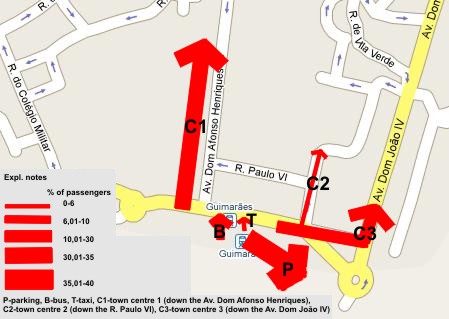
Pict. 1: The Guimarães station situation on the map
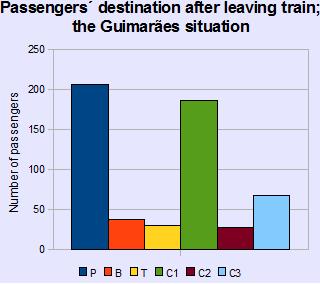
Chart 1: Passengers´ destination after leaving the train in Guimarães (total 555 passengers)
Expl. notes: P - parking, B - bus, T - taxi, C1 - town centre down the Av. Dom Afonso Henriques, C2 - town centre down the R. Paulo VI, C3 - town centre down the Av. Dom João IV
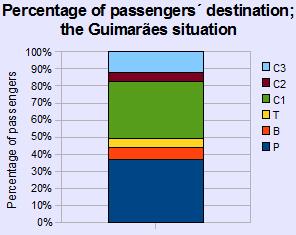
Chart 2: Percentage of passengers´ destination in Guimarães
Expl. notes: P - parking, B - bus, T - taxi, C1 - town centre down the Av. Dom Afonso Henriques, C2 - town centre down the R. Paulo VI, C3 - town centre down the Av. Dom João IV
The Vila das Aves situation
The situation in Vila das Aves when the train arrivals is simple – each -:39 minutes with trains from Guimarães, -:09 from Porto (with an exception like the arrival at 16:19 from Guimarães).
HYPOTHESIS There is no possibility for passengers to take a bus from the station to other parts of the town or to the nearest villages. Therefore, passengers can use their own cars, taxi or travel on foot. The station has two platforms but trains usually arrive at the 2nd platform. The first platform that is located by the main station building is not used (like the building – there is a waiting room and a café but the doors are locked).
RESULTS From 29th January to 2nd February I monitored a total 22 arrivals with 367 passengers. Almost 56% of passengers continue from the station on foot. The most frequently direction is down the R. Augusto Marques or Av. Conde Vizela (32,7%), then down the R. Silva Araújo (22,1%). The last „walking“ possibility is to go through the underpass to another part of the town (there are also parking places) but this journey is not used frequently (only 1,1% passengers went there). The most common way of transport is by car. Parking possibilities are sufficient therefore passengers can leave their car just next to the station. Almost 36% of passengers take advantage of good parking by the station. There is also a taxi rank next to the station and about 8,2% passengers took this type of transport. My opinion is that the station is oversized. The main building goes along the 1st platform and this part of station is almost always empty. There is no chance to stay in the waiting room or take a café in the station. That means the station could have been built with only one track. The second track (1st platform) is rarely used . Also the underpass is useless because there are another two underpasses near the station to cross the track safely.
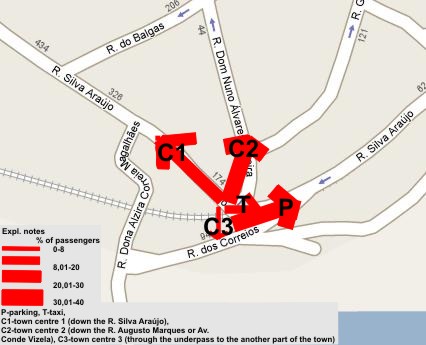
Pict. 2: The Vila das Aves situation on the map
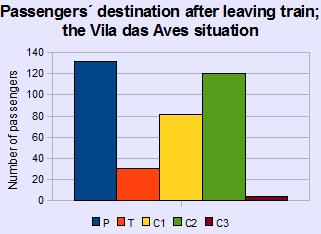
Chart 3: Passengers´ destination after leaving train in Vila das Aves (total 367 passengers)
Expl. notes: P - parking, T - taxi, C1 - town centre down the Av. Dom Afonso Henriques, C2 - town centre down the R. Paulo VI, C3 - town centre down the Av. Dom João IV
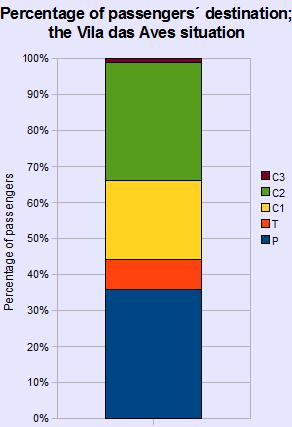
Chart 4: Percentage of passengers´ destination in Vila das Aves
Expl. notes: P - parking, T - taxi, C1 - town centre down the Av. Dom Afonso Henriques, C2 - town centre down the R. Paulo VI, C3 - town centre down the Av. Dom João IV
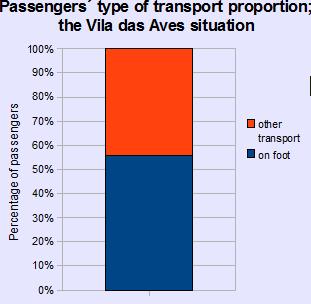
Chart 5: Passengers´ type of transport
The Santo Tirso situation
Santo Tirso is also a terminal station of trains from Porto (5 trains daily on week-days). That means a higher number of trains arriving at the station in comparison with Vila das Aves.
HYPOTHESIS There is a large free parking in the S. Tirso station with more than 100 places. But surprisingly there is no stop for buses that could take the passengers further to the town because the station is located far away from the town centre, about 15 minutes walking. I also wanted to add one more column to my result table – those people who take taxi from the station. But, while there is a taxi rank in front of the station, I couldn't see ANY taxi car during the time of my research at this station. These all mean passengers have two possibilities – 1. to go to the centre on foot, 2. to take a car from the station.
RESULTS From 20th January to 26th January 2009 I monitored 23 arrivals, with a total 286 passengers. Almost 58% of passengers use their own cars to get to the station and back. There are two parking-sites at the station. The main one is placed in front of the station building and the smaller one (with about 15 places) is located by the second platform. The largest one is used by 51,4% passengers who arrive at the station, about 6,3% passengers use the smaller one. As I mentioned there is no possibility to take a bus to the centre of Santo Tirso. Passengers (35,7%) use the pavement along the R. do Dr. Oliveira Salazar. There is a neighbouhood called Bolás in the opposite direction, about 6,6% of passengers continue there from the station. I must also mention the fact that the second (smaller one) parking-site is especially used by passengers who arrive to Santo Tirso by the Porto-Santo Tirso train that arrives at the second platform. Therefore the passengers needn´t cross the bridge (overpass) to get to the main parking places. It is also interesting to observe a difference in the number (average) of passengers who get off the train in Santo Tirso. About 21,5 passengers arrive by the Porto-Santo Tirso trains that terminate here in the station at the second platform (and many of them use the second parking). More than 15 passengers on average use the trains Porto-Guimarães, there is no difference except in the number of stops in Leandro between these two trains. About 6,3 passengers come from the Guimarães-Porto trains. The last possible train is Lousado-Guimarães that connects the Porto-Braga trains. I could monitor just two arrivals of these trains so the results are not relevant.
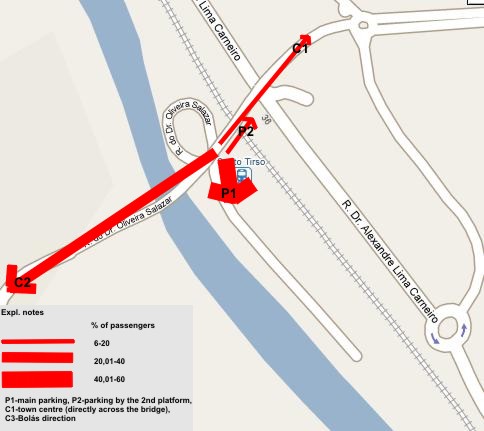
Pict. 3: The Santo Tirso situation on the map
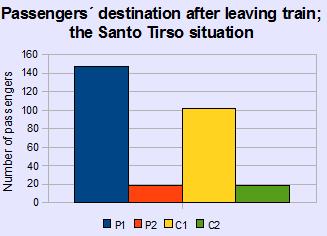
Chart 6: Passengers´ destination after leaving train in Santo Tirso (total 286 passengers)
Expl. notes: P1 - main parking, P2 - parking by the 2nd platform, C1 - town centre directly across the bridge and down the R. do Dr. Oliveira Salazar, C2 - Bolás direction
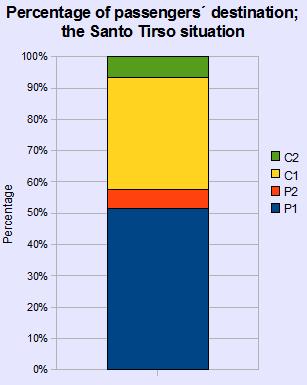
Chart 7: Percentage of passengers´ destination in Santo Tirso
Expl. notes: P1 - main parking, P2 - parking by the 2nd platform, C1 - town centre directly across the bridge and down the R. do Dr. Oliveira Salazar, C2 - Bolás direction
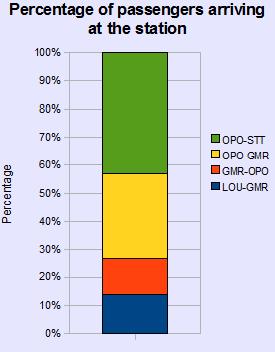
Chart 8: Percentage of passengers arriving at Santo Tirso
Expl. notes: OPO - Porto, STT - Santo Tirso, GMR - Guimarães, LOU-Lousado
